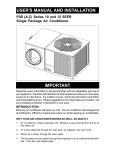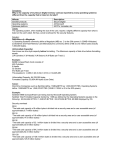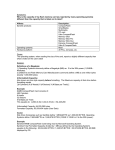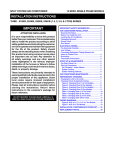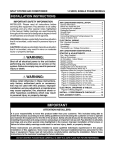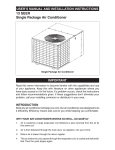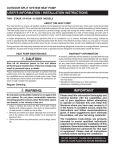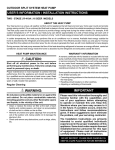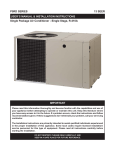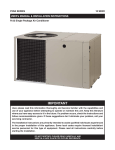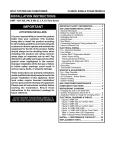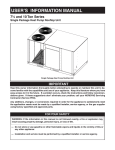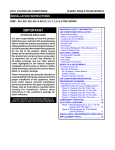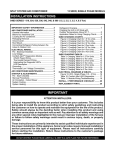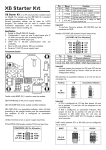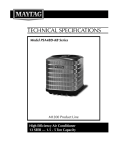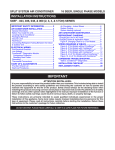Download Installation Instructions - A
Transcript
JS5BD Series 13 SEER User’s Manual / Installation Instructions Split system air conditioner - R-22 IMPORTANT Please read this information thoroughly and become familiar with the capabilities and use of your appliance before attempting to operate or maintain this unit. Keep this literature where you have easy access to it in the future. If a problem occurs, check the instructions and follow recommendations given. If these suggestions don’t eliminate the problem, call your servicing contractor. The Installation Instructions are primarily intended to assist qualified individuals experienced in the proper installation of this appliance. Some local codes require licensed installation/service personnel for this type of equipment. Please read all instructions carefully before starting the installation. DO NOT DESTROY. PLEASE READ CAREFULLY AND KEEP IN A SAFE PLACE FOR FUTURE REFERENCE. USER INFORMATION Important Safety Information.....................................3 Operating Instructions................................................3 Cooling Operation......................................................3 Heating Operation......................................................3 Operating the Air Conditioner for Automatic Cooling and Heating...................................................3 Operating the Indoor Blower Continuously.................3 Turning the Air Conditioner Off...................................3 Air Conditioner Maintenance......................................3 Troubleshooting...........................................................3 Warranty Information A warranty certificate with full details is included with the air conditioner. Carefully review these responsibilities with your dealer or service company. The manufacturer will not be responsible for any costs found necessary to correct problems due to improper setup, improper installation, adjustments, improper operating procedure on the part of the user, etc. Some specific examples of service calls which are not included in the limited warranty are: • Correcting wiring problems in the electrical circuit supplying the air conditioner. • Resetting circuit breakers or other switches. • Adjusting or calibrating of thermostat. INSTALLER INFORMATION Important Safety Information.....................................4 Air Conditioner Installation........................................5 General Information....................................................5 Before You Install this Unit..........................................5 Locating the Air conditioner........................................5 Packaging Removal....................................................5 Ground Level..............................................................5 Connecting Refrigerant Tubing between the Indoor & Outdoor Unit................................................6 Electrical Wiring...........................................................6 Pre - Electrical Checklist............................................6 Line Voltage................................................................6 Grounding..................................................................7 Thermostat Connections............................................7 Positive Temp. Coefficient Resistor (PTCR)...............7 Startup & Adjustments...............................................7 Pre - Start Checklist...................................................7 Start-up Procedures...................................................7 Air Circulation - Indoor Blower................................7 System Cooling.......................................................8 System Heating.......................................................8 Refrigerant Charging..................................................8 Charging R-22 Units in AC Mode with Outdoor Temperatures Above 55° F........................8 Air Conditioner Maintenance......................................9 Replacement Parts......................................................9 2 Figures & Tables........................................................10 Figure 4. Unit Dimensions ....................................10 Refrigerant Charging Charts....................................10 Figure 5. JS5BD-018KA (1.5 Ton Units)................10 Figure 6. JS5BD-024KB (2 Ton Units)...................11 Figure 7. JS5BD-030KB (2.5 Ton Units)................11 Figure 8. JS5BD-036KB (3 Ton Units)...................12 Figure 9. JS5BD-042KA (3.5 Ton Units)................12 Figure 10. JS5BD-048KA (4 Ton Units).................13 Figure 11. JS5BD-060KA (5 Ton Units).................13 Refrigerant Charging Tables.....................................14 Table 4. JS5BD-018KA (1.5 Ton Units).................14 Table 5. JS5BD-024KB (2 Ton Units)....................14 Table 6. JS5BD-030KB (2.5 Ton Units).................15 Table 7. JS5BD-036KB (3 Ton Units)....................15 Table 8. JS5BD-042KA (3.5 Ton Units).................16 Table 9. JS5BD-048KA (4 Ton Units)....................16 Table 10. JS5BD-060KA (5 Ton Units)..................17 Electrical Information................................................17 Table 11. Electrical Specs & Physical Data...........17 Figure 12. JT5BD Wiring Diagram........................18 USER INFORMATION important SAFETY INFORMATION Safety markings are used frequently throughout this manual to designate a degree or level of seriousness and should not be ignored. WARNING indicates a potentially hazardous situation that if not avoided, could result in personal injury or death. CAUTION indicates a potentially hazardous situation that if not avoided, may result in minor or moderate injury or property damage. The continuous indoor blower operation can be obtained with the thermostat system mode set in any position, including OFF. Turning the Air Conditioner OFF Change the thermostat’s system mode to OFF and the fan mode to AUTO (See Figure 1). NOTE: The system will not operate, regardless of the temperature selector setting. Operating Instructions NOTE: Thermostat styles vary. Some models may not include the AUTO mode and others will have the AUTO in place of the HEAT and COOL. Others may include all three. Please refer to the thermostat manufacturer’s User manual for detailed programming instructions. Cooling Operation 1. Set the thermostat’s system mode to COOL or AUTO and change the fan mode to AUTO. See Figure 1. 2. Set the temperature selector to the desired temperature level. The outdoor fan, compressor, and blower motor will all cycle on and off to maintain the indoor temperature at the desired cooling level. NOTE: If the temperature level is re-adjusted, or the system mode is reset, the fan and compressor in the outdoor unit may not start immediately. A protective timer circuit holds the compressor and the outdoor fan off for approximately 5 minutes following a previous operation or the interruption of the main electrical power (if applicable). Fan Mode System Mode Temperature Selector Figure 1. Digital Thermostat AIR CONDITIONER Maintenance Proper maintenance is most important to achieve the best performance from the appliance and should be performed frequently at the beginning of each air conditioning season. WARNING: Heating Operation 1. Set the thermostat’s system mode to HEAT or AUTO and change the fan mode to AUTO. See Figure 1. 2. Set the temperature selector to the desired temperature level. The optional heating equipment (furnace or electric heat) will cycle on & off to maintain the indoor temperature at the desired temperature level. Your air conditioner contains liquid and gaseous refrigerant under pressure. Installation and servicing should only be attempted by qualified, trained personnel thoroughly familiar with the equipment and safe responsible refrigerant handling procedures. Failure to comply with this warning could result in equipment damage, personal injury, or death. Operating the AC for Automatic Cooling & Heating 1. Set the thermostat system mode to AUTO and the thermostat fan mode to AUTO. See Figure 1. 2. Set the thermostat temperature selector to the desired temperature level. The thermostat will maintain the desired temperature level by switching between either the outdoor cooling unit or the indoor heating unit (furnace or electric heat) automatically. • Keep the outdoor unit clean. Hose off periodically and keep unit fins clear of leaves and grass clippings. • Keep the outdoor unit clear of obstructions. DO NOT obstruct airflow with tall plants or shrubs. DO NOT store gasoline or other flammable materials on or near the outdoor unit. • Never operate the appliance without a filter installed in the return air duct. Inspect filters frequently and replace when necessary with filter of same dimensional size. Operating the Indoor Blower Continuously The continuous indoor blower operation is typically used to circulate the indoor air to equalize a temperature unbalance due to a sun load, cooking, or fireplace operation. Set the thermostat fan mode to ON (Figure 1). The indoor blower starts immediately, and will run continually until the fan mode is reset to AUTO. • Check the thermostat setting. Make sure the system mode and temperature settings are correct. • Check the electrical panel for tripped circuit breakers. • Check the filters for dust accumulation. • Check the outdoor unit and make sure it is clean and not covered with grass or leaves. Troubleshooting 3 INSTALLER INFORMATION important SAFETY INFORMATION INSTALLER: Please read all instructions before servicing this equipment. Pay attention to all safety warnings and any other special notes highlighted in the manual. Safety markings are used frequently throughout this manual to designate a degree or level of seriousness and should not be ignored. WARNING indicates a potentially hazardous situation that if not avoided, could result in personal injury or death. CAUTION indicates a potentially hazardous situation that if not avoided, may result in minor or moderate injury or property damage. WARNING: Shut off all electrical power to the unit before performing any maintenance or service on the system. Failure to comply may result in personal injury or death. WARNING: Unless noted otherwise in these instructions, only factory authorized parts or accessory kits may be used with this product. Improper installation, service, adjustment, or maintenance may cause explosion, fire, electrical shock or other hazardous conditions which may result in personal injury or property damage WARNING: JS5BD Split System Air conditioners leave the factory with a nitrogen holding charge. Follow all charging instructions for maximum unit performance and efficiency. Some local codes require licensed installation/service personnel to service this type of equipment. Refrigerant charging must be done by qualified personnel familiar with safe and environmentally responsible refrigerant handling procedures. Under no circumstances should the owner attempt to install and/or service this equipment. Failure to comply with this warning could result in property damage, personal injury, or death. 4 CAUTION: This unit uses refrigerant R-22. DO NOT use any other refrigerant in this unit. Use of another refrigerant will damage the unit. WARNING: The information listed below must be followed during the installation, service, and operation of this unit. Unqualified individuals should not attempt to interpret these instructions or install this equipment. Failure to follow safety recommendations could result in possible damage to the equipment, serious personal injury or death. • The installer must comply with all local codes and regulations which govern the installation of this type of equipment. Local codes and regulations take precedence over any recommendations contained in these instructions. Consult local building codes and the National Electrical Code (ANSI CI) for special installation requirements. • All electrical wiring must be completed in accordance with local, state and national codes and regulations and with the National Electric Code (ANSI/NFPA 70) or in Canada the Canadian Electric Code Part 1 CSA C.22.1. • This equipment contains liquid and gaseous refrigerant under high pressure. DO NOT USE ANY PORTION OF THE CHARGE FOR PURGING OR LEAK TESTING. Installation or servicing should only be performed by qualified trained personnel thoroughly familiar with this type equipment. • Fully annealed, refrigerant grade copper tubing should be used when installing the system. Refrigerant suction line tubing should be fully insulated. • Installation of equipment may require brazing operations. Installer must comply with safety codes and wear appropriate safety equipment (safety glasses, work gloves, fire extinguisher, etc.) when performing brazing operations. • Follow all precautions in the literature, on tags, and on labels provided with the equipment. Read and thoroughly understand the instructions provided with the equipment prior to performing the installation and operational checkout of the equipment. Air conditioner INSTallATION General Information The JS5BD series air conditioner is designed only for outdoor rooftop or ground level installations. This unit has been tested for capacity and efficiency in accordance with A.H.R.I. Standards and will provide many years of safe and dependable comfort, providing it is properly installed and maintained. Abuse, improper use, and/or improper maintenance can shorten the life of the appliance and create unsafe hazards. To achieve optimum performance and minimize equipment failure, it is recommended that periodic maintenance be performed on this unit. The ability to properly perform maintenance on this equipment requires certain mechanical skills and tools. Before You Install this Unit √ The cooling load of the area to be conditioned must be calculated and a system of the proper capacity selected. It is recommended that the area to be conditioned be completely insulated and vapor sealed. √ Check the electrical supply and verify the power supply is adequate for unit operation.The system must be wired and provided with circuit protection in accordance with local building codes. If there is any question concerning the power supply, contact the local power company. √ The indoor section (air handler, furnace, etc) should be installed before routing the refrigerant tubing. Refer to the indoor unit's installation instructions for installation details. √ All units are securely packed at the time of shipment and upon arrival should be carefully inspected for damage prior to installing the equipment at the job site. Verify coil fins are straight. If necessary, comb fins to remove flattened or bent fins. Claims for damage (apparent or concealed) should be filed immediately with the carrier. √ Please consult your dealer for maintenance information and availability of maintenance contracts. Please read all instructions before installing the unit. 18" DO NOT OBSTRUCT TOP OF UNIT Locating the Air Conditioner • Survey the job site to determine the best location for mounting the outdoor unit. See Figure 5 (page 12) for unit dimensions. • Overhead obstructions, poorly ventilated areas, and areas subject to accumulation of debris should be avoided. • Sufficient clearance for unobstructed airflow through the outdoor coil must be maintained in order to achieve rated performance. See Figure 2 for minimum clearances to obstructions. • Consideration should be given to availability of electric power, service access, noise, and shade. Packaging Removal NOTE: To prevent damage to the tubing connections, carefully remove the carton and user’s manual from the equipment. Discard the shipping carton. Ground Level Ground level installations must be located according to local building codes or ordinances and these requirements: • Clearances must be in accordance with those shown in Figure 2. • A suitable mounting pad (Figure 3) must be provided and separate from the building foundation. The pad must be level and strong enough to support the weight of the unit. The slab height must be a minimum of 2” (5 cm) above grade and with adequate drainage. 2” Figure 3. Ground Level Installation 18" 18" 18" Figure 2. Clearance Requirements 5 Connecting Refrigerant Tubing Between the Indoor & Outdoor Unit CAUTION: This system uses R-22 refrigerant with POE oil. When servicing, cover or seal openings to minimize the exposure of the refrigerant system to air to prevent accumulation of moisture and other contaminants. After outdoor and indoor unit placement has been determined, route refrigerant tubing between the equipment in accordance with sound installation practices. • When connecting refrigerant linesets together, it is recommended that dry nitrogen be flowing through the joints during brazing to prevent internal oxidation and scaling. • Refrigerant tubing should be routed in a manner that minimizes the length of tubing and the number of bends in the tubing. If precise forming of refrigerant lines is required, a copper tubing bender is recommended. Avoid sharp bends and contact of the refrigerant lines with metal surfaces. • Refrigerant tubing should be supported in a manner that the tubing will not vibrate or abrade during system operation. • Tubing should be kept clean of foreign debris during installation. • Every effort should be made by the installer to ensure that the field installed refrigerant containing components of the system have been installed in accordance with these instructions and sound installation practices to insure reliable system operation and longevity. • The maximum recommended interconnecting refrigerant line lengths is 75 ft. and the vertical elevation difference between the indoor and outdoor sections should not exceed 20 ft. COPPER WIRE SIZE — AWG (1% Voltage Drop) Supply Wire Length-Feet 200 50 Supply Circuit Ampacity 150 100 6 8 10 14 15 4 6 8 12 20 4 6 8 10 25 4 4 6 10 30 3 4 6 8 35 3 4 6 8 40 2 3 4 6 45 2 3 4 6 50 2 3 4 6 55 1 2 3 4 60 Wire Size based on N.E.C. for 60° type copper conductors. Table 1. Copper Wire Size 6 • To maintain the unit's warranty, it is required that a filter drier be installed when the system is open to the atmosphere. This includes, but is not limited to, replacing the evaporator and/or condenser of a system. The filter drier must be installed in strict accordance with the manufacturer’s installation instructions. • Optional equipment such as liquid line solenoid valves, low ambient, etc., should be installed in strict accordance with the manufacturer’s installation instructions. ELECTRICAL WIRING WARNING: To avoid risk of electrical shock, personal injury, or death, disconnect all electrical power to the unit before performing any maintenance or service. The unit may have more than one electrical supply. Label all wires prior to disconnection when servicing the unit. Wiring errors can cause improper and dangerous operation. • All electrical connections must be in compliance with all applicable local codes and ordinances, and with the current revision of the National Electric Code (ANSI/NFPA 70). • For Canadian installations the electrical connections and grounding shall comply with the current Canadian Electrical Code (CSA C22.1 and/or local codes). Pre-Electrical Checklist √ Verify that the voltage, frequency, and phase of the supply source match the specifications on the unit rating plate. See Table 11 (page 17). √ Verify that the service provided by the utility is sufficient to handle the additional load imposed by this equipment. Refer to the unit wiring label for proper voltage wiring. √ Verify factory wiring is in accordance with the unit wiring diagram (Figure 12, page 18). Inspect for loose connections. Line Voltage • A wiring diagram is located on the inside cover of the electrical box of the outdoor unit. The installer should become familiar with the wiring diagram before making any electrical connections to the outdoor unit. • An electrical disconnect must be located within sight of and readily accessible to the unit. This switch shall be capable of electrically de-energizing the outdoor unit. • Line voltage to the unit should be supplied from a dedicated branch circuit containing the correct fuse or circuit breaker for the unit. Incoming field wiring and minimum size of electrical conductors and circuit protection must be in compliance with information listed • • • • • • on the outdoor unit data label. Any other wiring methods must be acceptable to authority having jurisdiction. The outdoor unit requires both power and control circuit electrical connections. Refer to the wiring diagram / schematic for identification and location of outdoor unit field wiring interfaces (Figure 12, page 18). Make all electrical connections in accordance with all applicable codes and ordinances. Overcurrent protection must be provided at the branch circuit distribution panel and sized as shown on the unit rating label and according to applicable local codes. See the unit rating plate for minimum circuit ampacity and maximum overcurrent protection limits. Provide power supply for the unit in accordance with the unit wiring diagram, and the unit rating plate. Connect the line-voltage leads to the terminals on the contactor inside the control compartment. Use only copper wire for the line voltage power supply to this unit as listed in Table 1 (page 6). Use proper code agency listed conduit and a conduit connector for connecting the supply wires to the unit. Use of rain tight conduit is recommended. 208/230 Volt units are shipped from the factory wired for 230 volt operation. For 208V operation, remove the lead from the transformer terminal marked 240V and connect it to the terminal marked 208V. Optional equipment requiring connection to the power or control circuits must be wired in strict accordance of the NEC (ANSI/NFPA 70), applicable local codes, and the instructions provided with the equipment. Grounding WARNING: The unit cabinet must have an uninterrupted or unbroken electrical ground to minimize personal injury if an electrical fault should occur. Do not use gas piping as an electrical ground! This unit must be electrically grounded in accordance with local codes or, in the absence of local codes, with the National Electrical Code (ANSI/NFPA 70) or the CSA C22.1 Electrical Code. Use the grounding lug provided in the control box for grounding the unit. Thermostat Wire Gauge Recommended T-Stat Wire Unit to T-Stat (Length in FT) 2-Wire (Heating) 5-Wire (Heating/Cooling) 55 25 22 90 45 20 140 70 18 225 110 24 Table 2. Thermostat Wire Gauge Thermostat Connections • Thermostat connections should be made in accordance with the instructions supplied with the thermostat and the indoor equipment. • The outdoor unit is designed to operate from a 24 VAC Class II control circuit. The control circuit wiring must comply with the current provisions of the NEC (ANSI/ NFPA 70) and with applicable local codes having jurisdiction. • The low voltage wires must be properly connected to the units low voltage terminal block. Recommended wire gauge and wire lengths for typical thermostat connections are listed in Table 2. • The thermostat should be mounted about 5 feet above the floor on an inside wall. DO NOT install the thermostat on an outside wall or any other location where its operation may be adversely affected by radiant heat from fireplaces, sunlight, or lighting fixtures, and convective heat from warm air registers or electrical appliances. Refer to the thermostat manufacturer’s instruction sheet for detailed mounting and installation information. Positive Temperature Coefficient Resistor (PTCR) (Select models only) The PTCR is factory installed and located on the control panel of the outdoor unit.This soft start device is for use with reciprocating compressors. If a hard start kit is needed on this unit, the soft start (PTCR) must be removed first. START UP & ADJUSTMENTS Pre-Start Check List √ Verify the indoor unit is level and allows proper condensate drainage. √ Verify the outdoor coil and top of the unit are free from obstructions and debris, and all equipment access/ control panels are in place. √ Verify air filters are cleaned and properly installed. √ Verify duct work is sealed to prevent air leakage. √ Verify line voltage power leads are securely connected and the unit is properly grounded. √ Verify low voltage wires are securely connected to the correct leads on the low voltage terminal strip. √ Verify power supply branch circuit overcurrent protection is sized properly. √ Verify the thermostat is wired correctly. Start-Up Procedures The thermostat's function mode should be set to OFF and the fan mode should be set to AUTO. Close all electrical disconnects to energize the system. Air Circulation - Indoor Blower 1. Set the thermostat system mode on OFF and the fan mode to ON. 2. Verify the blower runs continuously. Check the air delivery at the supply registers and adjust register openings for balanced air distribution. If insufficient air is detected, examine ductwork for leaks or obstructions. 7 3. Set the thermostat fan mode to AUTO and verify the blower stops running. System Cooling 1. Set the thermostat’s system mode to COOL and the fan mode to AUTO. Gradually lower the thermostat temperature setpoint below room temperature and verify the outdoor unit and indoor blower energize. 2. Verify blower wheel is spinning in direction indicated by arrow. Feel the air being circulated by the indoor blower and verify that it is cooler than ambient temperature. Listen for any unusual noises. If unusual sounds occur, determine the source of the noise and correct as necessary. 3. Verify HI and LO refrigerant pressures. 4. Allow the system to operate for several minutes and then set the temperature selector above room temperature. Verify the fan and compressor cycle off with the thermostat. NOTE: The blower should also stop unless fan mode is set to the ON position. System Heating (optional) 1. Set the thermostat's system mode to HEAT and the temperature mode above room temperature. 2. Verify the optional heating equipment (furnace or electric heat) and indoor blower energize. Feel the air being circulated by the indoor blower and verify that it is warmer than ambient temperature. Listen for any unusual noises. If unusual sounds occur, determine the source of the noise and correct as necessary. Refrigerant Charging WARNING: JS5BD Split system air conditioners leave the factory with a nitrogen holding charge. DO NOT operate any unit while it contains a Nitrogen holding charge. Doing so may damage the units compressor. Follow these charging instructions for maximum unit performance and efficiency. Some local codes require licensed installation/ service personnel to service this type of equipment. Refrigerant charging must be done by qualified personnel familiar with safe and environmentally responsible refrigerant handling procedures. Under no circumstances should the owner attempt to install and/or service this equipment. Failure to comply with this warning could result in property damage, personal injury, or death. To properly charge these units: 1. Read all Installation Instructions first. 2. Complete any brazing operations. (e.g. Split system line-sets) 8 3. Leak check and evacuate the whole system using proper methods. 4. Purge the nitrogen holding charge. 5. Evacuate the unit to 350-500 microns. 6. Allow the unit to remain under vacuum for at least 30 min. 7. Weigh-In the proper amount of new (or reclaimed) R-22 refrigerant. Refer to Table 3 or the units rating label to determine the correct amount of charge. • Refrigerant charging charts are applicable only to matched assemblies of NORDYNE equipment and listed airflows for the indoor coil. Refer to Figures 5 11 (Pages 10 - 13) for correct system charging. • JS5BD outdoor units with indoor coils not listed are not recommended. Deviations from rated airflows or non-listed combinations may require modification to the expansion device and refrigerant charging procedures for proper and efficient system operation. • The refrigerant charge can be checked and adjusted through the service ports provided external to the outdoor unit. Use only gage line sets which have a “Schrader” depression device present to actuate the valve. Charging an R-22 system in AC mode at outdoor temperatures above 55° F for optimized sub-cooling of 10° F - 12° F. 1. With the system operating at steady-state, measure the liquid refrigerant pressure (in psig) at the outdoor unit service valve. 2. Measure the liquid refrigerant temperature (in Fahrenheit) at the service valve. 3. Determine the required liquid refrigerant pressure. Refer to Tables 4 - 10 (pages 14 - 17) for correct system charging. • If the pressure measured in Step 1 is greater than the required liquid refrigerant pressure determined in Step 3, then there is too much charge in the system. Remove refrigerant and repeat Steps 1 through 3 until the system is correctly charged. • If the pressure measured in Step 1 is less than the required liquid refrigerant pressure determined in Step 3, there is too little charge in the system. Add refrigerant and repeat Steps 1 through 3 until the system is correctly charged. Model Number Restrictor Bore Size (inches) System charge R-22 (oz.) 018KA 024KB 030KB 036KB 042KA 048KA 060KA 0.053 0.060 0.065 0.075 0.078 0.089 0.099 78 53 56 68 122 126 160 Table 3. Refrigerant Metering Device for 13 SEER Split System Air Conditioner Air conditioner MAINTENANCE WARNING: To prevent electrical shock, personal injury, or death, disconnect all electrical power to the unit before performing any maintenance or service. The unit may have more than one electrical supply. Proper maintenance is important to achieve optimum performance from the air conditioner.The ability to properly perform maintenance on this equipment requires certain mechanical skills and tools. If you do not possess these skills, contact your dealer for maintenance. Consult your local dealer about the availability of maintenance contracts. Routine maintenance should include the following: • Inspect and clean or replace air filters at the beginning of each heating and cooling season, or more frequently if required. • Inspect the condensate drain and outdoor coil at the beginning of each cooling season. Remove any debris. Clean the outdoor coil and louvers as necessary using a mild detergent and water. Rinse thoroughly with water. • Inspect the electrical connections for tightness at the beginning of each heating and cooling season. Service as necessary. CAUTION: The unit should never be operated without a filter in the return air system. Replace disposable filters with the same type and size. • Do not attempt to add additional oil to motors unequipped with oil tubes. The compressor is hermetically sealed at the factory and does not require lubrication. REPLACEMENT PARTS Replacement parts are available through all Nordyne distributors. Please have the complete model and serial number of the unit when ordering replacement parts. ELECTRICAL: Capacitors Temperature Limit Switches Compressors Thermostats Contactors Time Delay Relays Pressure Switches Transformers Relays MOTORS: Blower Motor Fan Motor COMPONENTS: Blower Assembly Fan Grille Cabinet Panels Filter/Driers Expansion Valves 9 FIGURES & TABLES DO NOT OBSTRUCT TOP OF UNIT Allow adequate clearance for airflow W D H Model Number JS5BD- Height -H- Width -W- Depth -D- 018KA 23" 22 3/4" 22 3/4" 024KB 23" 22 3/4" 22 3/4" 030KB 27" 22 3/4" 22 3/4" 036KB 27" 22 3/4" 22 3/4" 042KA 31" 30 3/4" 30 3/4" 048KA 060KA 31" 43" 30 3/4" 30 3/4" 30 3/4" 30 3/4" Figure 4. Unit Dimensions TXV Cooling Charging Charts JS5BD-018KA SERIES CHARGING CHART 400 380 Liquid Pressure (psig) 360 Remove refrigerant when above curve 340 320 300 280 260 240 220 Add refrigerant when below curve 200 180 160 140 75 80 85 90 95 100 105 110 115 120 Liquid Temperature (F) Figure 5. Charging Chart for 1.5 Ton Units 10 125 130 135 JS5BD-024KB SERIES CHARGING CHART 400 380 Liquid Pressure (psig) 360 Remove refrigerant when above curve 340 320 300 280 260 240 220 Add refrigerant when below curve 200 180 160 140 75 80 85 90 95 100 105 110 115 120 125 130 135 Liquid Temperature (F) Figure 6. Charging Chart for 2 Ton Units (with Microchannel Coil) JS5BD-030KB SERIES CHARGING CHART 400 380 Liquid Pressure (psig) 360 Remove refrigerant when above curve 340 320 300 280 260 240 220 Add refrigerant when below curve 200 180 160 140 75 80 85 90 95 100 105 110 115 120 125 130 135 Liquid Temperature (F) Figure 7. Charging Chart for 2.5 Ton Units (with Microchannel Coil) 11 JS5BD-036KB SERIES CHARGING CHART 400 380 Liquid Pressure (psig) 360 Remove refrigerant when above curve 340 320 300 280 260 240 220 Add refrigerant when below curve 200 180 160 140 75 80 85 90 95 100 105 110 115 120 125 130 135 Liquid Temperature (F) Figure 8. Charging Chart for 3 Ton Units (with Microchannel Coil) JS5BD-042KA SERIES CHARGING CHART 400 380 Liquid Pressure (psig) 360 Remove refrigerant when above curve 340 320 300 280 260 240 220 Add refrigerant when below curve 200 180 160 140 75 80 85 90 95 100 105 110 115 120 Liquid Temperature (F) Figure 9. Charging Chart for 3.5 Ton Units 12 125 130 135 JS5BD-048KA SERIES CHARGING CHART 400 380 Liquid Pressure (psig) 360 Remove refrigerant when above curve 340 320 300 280 260 240 220 Add refrigerant when below curve 200 180 160 140 75 80 85 90 95 100 105 110 115 120 125 130 135 Liquid Temperature (F) Figure 10. Charging Chart for 4 Ton Units JS5BD-060KA SERIES CHARGING CHART 400 380 Liquid Pressure (psig) 360 Remove refrigerant when above curve 340 320 300 280 260 240 220 Add refrigerant when below curve 200 180 160 140 75 80 85 90 95 100 105 110 115 120 125 130 135 Liquid Temperature (F) Figure 11. Charging Chart for 5 Ton Units 13 FIGURES & TABLES Refrigerant Charging tables Shaded boxes indicate flooded conditions. Rated design values. The suction pressure will vary from design value if indoor air flow, entering dry bulb, or entering wet bulb temperatures are lower than design. 1. All pressures are listed in psig and all temperatures in ° F 2. Discharge temperatures greater than charted values indicate an undercharged system. OUTDOOR TEMPERATURE (° F) Suct. Press. 70 75 80 85 90 95 100 105 Liq. Dis. Liq. Dis. Liq. Dis. Liq. Dis. Liq. Dis. Liq. Dis. Liq. Dis. Liq. Dis. Press. Temp. Press. Temp. Press. Temp. Press. Temp. Press. Temp. Press. Temp. Press. Temp. Press. Temp. 74 156 76 159 119 124 173 78 161 130 175 131 190 133 80 161 139 177 136 192 138 82 165 142 178 143 194 142 208 144 223 182 146 195 148 211 148 225 150 239 199 151 213 153 227 154 241 156 256 157 88 216 157 230 158 243 160 258 161 90 220 160 233 162 247 164 260 165 274 166 237 166 250 168 264 169 276 170 254 172 84 126 86 206 139 92 145 94 151 96 272 163 267 174 281 175 271 178 284 180 288 184 98 100 Table 4. Charging Table for JS5BD-018KA Series (1.5 Ton Units) OUTDOOR TEMPERATURE (° F) Suct. Press. 70 75 80 85 90 95 100 105 Liq. Dis. Liq. Dis. Liq. Dis. Liq. Dis. Liq. Dis. Liq. Dis. Liq. Dis. Liq. Dis. Press. Temp. Press. Temp. Press. Temp. Press. Temp. Press. Temp. Press. Temp. Press. Temp. Press. Temp. 71 149 103 73 152 109 167 75 154 114 170 120 185 77 154 124 172 125 187 131 203 137 79 157 126 172 132 190 135 205 141 176 135 191 141 207 146 223 151 239 194 145 209 150 225 156 241 162 257 167 85 213 154 228 160 243 166 259 171 274 87 216 158 231 164 246 170 261 175 276 181 235 168 250 174 265 180 278 185 253 178 81 83 89 91 93 115 126 221 147 157 268 184 283 190 272 188 287 194 290 199 95 97 Table 5. Charging Table for JS5BD-024KB Series (2 Ton Units with Microchannel Coil) 14 177 Refrigerant Charging tables Shaded boxes indicate flooded conditions. Rated design values. The suction pressure will vary from design value if indoor air flow, entering dry bulb, or entering wet bulb temperatures are lower than design. 1. All pressures are listed in psig and all temperatures in ° F 2. Discharge temperatures greater than charted values indicate an undercharged system. OUTDOOR TEMPERATURE (° F) Suct. Press. 70 75 80 85 90 95 100 105 Liq. Dis. Liq. Dis. Liq. Dis. Liq. Dis. Liq. Dis. Liq. Dis. Liq. Dis. Liq. Dis. Press. Temp. Press. Temp. Press. Temp. Press. Temp. Press. Temp. Press. Temp. Press. Temp. Press. Temp. 68 139 94 70 142 100 158 108 72 144 105 160 113 74 142 118 162 118 178 125 194 76 145 121 161 127 180 130 196 137 212 165 130 180 137 198 142 214 149 230 184 140 199 147 216 153 232 160 248 167 82 203 151 218 158 234 164 250 171 84 206 154 222 161 237 168 252 175 268 182 225 165 241 173 256 180 270 186 244 177 78 80 176 120 133 86 144 88 156 90 266 178 260 184 275 191 263 188 279 196 282 200 92 94 Table 6. Charging Table for JS5BD-030KB Series (2.5 Ton Units with Microchannel Coil) OUTDOOR TEMPERATURE (° F) Suct. Press. 70 75 80 85 90 95 69 147 99 71 150 105 167 152 110 169 118 186 75 150 124 171 123 188 131 205 77 153 126 170 133 190 136 207 144 224 151 174 136 190 143 209 148 226 156 194 146 81 105 113 73 79 100 Liq. Dis. Liq. Dis. Liq. Dis. Liq. Dis. Liq. Dis. Liq. Dis. Liq. Dis. Liq. Dis. Press. Temp. Press. Temp. Press. Temp. Press. Temp. Press. Temp. Press. Temp. Press. Temp. Press. Temp. 126 139 243 163 210 153 228 160 245 168 262 175 83 214 157 230 164 247 172 264 179 281 85 217 161 234 168 251 176 266 183 283 190 237 172 254 180 271 187 285 194 257 184 274 192 291 199 277 196 294 204 297 208 87 89 91 93 186 95 Table 7. Charging Table for JS5BD-036KB Series (3 Ton Units with Microchannel Coil) 15 Refrigerant Charging tables Shaded boxes indicate flooded conditions. Rated design values. The suction pressure will vary from design value if indoor air flow, entering dry bulb, or entering wet bulb temperatures are lower than design. 1. All pressures are listed in psig and all temperatures in ° F 2. Discharge temperatures greater than charted values indicate an undercharged system. OUTDOOR TEMPERATURE (° F) Suct. Press. 70 75 80 85 90 95 100 105 Liq. Dis. Liq. Dis. Liq. Dis. Liq. Dis. Liq. Dis. Liq. Dis. Liq. Dis. Liq. Dis. Press. Temp. Press. Temp. Press. Temp. Press. Temp. Press. Temp. Press. Temp. Press. Temp. Press. Temp. 73 174 75 176 138 143 186 77 178 149 188 147 198 146 79 181 153 190 152 200 151 81 185 156 193 156 202 156 212 155 222 197 159 205 160 214 159 224 158 234 209 163 217 163 226 163 236 162 246 162 87 221 167 229 167 238 166 248 166 258 165 89 224 170 233 171 242 170 250 170 260 169 236 174 245 174 254 174 262 173 248 178 257 178 266 177 260 182 269 182 272 186 83 142 85 210 150 91 154 93 158 95 97 99 Table 8. Charging Table for JS5BD-042KA Series (3.5 Ton Units) OUTDOOR TEMPERATURE (° F) Suct. Press. 70 75 80 85 90 95 150 125 74 153 130 167 76 155 135 169 136 184 78 155 144 171 141 186 143 200 80 159 147 172 148 188 148 202 149 217 151 176 151 190 153 204 154 219 155 193 156 84 131 138 144 233 157 207 158 221 159 235 161 249 162 86 210 162 224 164 237 165 251 166 266 88 213 165 227 167 241 169 253 170 268 172 230 171 244 173 257 175 270 176 247 177 90 92 94 168 261 179 274 181 264 183 278 185 281 190 96 98 Table 9. Charging Table for JS5BD-048KA Series (4 Ton Units) 16 105 Liq. Dis. Liq. Dis. Liq. Dis. Liq. Dis. Liq. Dis. Liq. Dis. Liq. Dis. Liq. Dis. Press. Temp. Press. Temp. Press. Temp. Press. Temp. Press. Temp. Press. Temp. Press. Temp. Press. Temp. 72 82 100 OUTDOOR TEMPERATURE (° F) Suct. Press. 70 75 80 85 90 95 100 105 Liq. Dis. Liq. Dis. Liq. Dis. Liq. Dis. Liq. Dis. Liq. Dis. Liq. Dis. Liq. Dis. Press. Temp. Press. Temp. Press. Temp. Press. Temp. Press. Temp. Press. Temp. Press. Temp. Press. Temp. 68 149 70 151 146 166 146 72 154 151 168 151 74 154 160 171 156 185 156 200 76 158 163 172 163 187 161 202 160 217 175 166 189 166 204 165 219 165 234 193 169 207 170 221 169 236 169 251 169 82 210 173 224 173 238 173 253 173 84 213 177 227 177 241 177 255 177 269 177 231 181 245 181 259 181 271 180 248 185 78 141 80 183 151 156 86 160 88 165 90 267 173 262 186 276 185 265 190 279 190 283 194 92 94 Table 10. Charging Table for JS5BD-060KA Series (5 Ton Units) electrical information Model Number JS5BD- 018KA 024KB 030KB 8.7 11.5 14.1 Volts-Cycles-Phase (1) Electrica Data 042KA 048KA 060KA 16.2 21.3 26.7 208/230-60-1 Total Amps 16.8 Delay Fuse Max. (2) 15 20 30 35 30 45 50 Min. Circuit Ampacity 10.8 14.1 17.5 20.6 19.9 26.3 33.1 8.2 9.9 9.9 9.9 17.7 17.7 25.4 Rows-FPI 1 - 22 1 - 18 1 - 18 1 - 18 1 - 22 1 - 22 1 - 22 Tube Dia 3/8” O.D. MC MC MC 3/8” O.D. 3/8” O.D. 3/8” O.D. Area Coil Type Component Data 036KB Fan Motor Fan Blade Compressor Data Refrigerant suction line: Length/O.D. Liquid Line: All lengths - 3/8” O.D. Amps 0.3 0.7 0.7 1.20 1.40 1.40 1.40 HP 1/20 1/10 1/10 1/4 1/4 1/4 1/4 Dia Blades 18” - 3 18” - 3 18” - 3 18” - 3 24” - 3 24” - 3 24” - 3 SCFM 1410 1985 3000 3000 4000 4000 4000 RLA 8.3 10.8 13.4 15.4 14.7 19.8 25.3 LRA 40.3 56.0 68.0 87.0 77.0 104.0 146.0 0-24 ft. 3/4” 3/4” 3/4” 3/4” 7/8” 7/8” 7/8” 25-39 ft. 3/4” 3/4” 7/8” (3) 7/8” (3) 7/8” 7/8” 1-1/8” (4) 40-75 ft. 3/4” 3/4” 7/8” (3) 7/8” (3) 1-1/8” (4) 1-1/8” (4) 1-1/8” (4) 78 53 56 68 122 126 160 Net 103 112 105 105 176 176 229 Ship 107 117 109 109 183 183 238 R-22 Refrigerant charge (in Ounces): (Outdoor unit, Indoor Unit 15’ Line Set) Approximate Weight (lbs.) PSC Table 11. Electrical Specifications & Physical Data 17 WIRING DIAGRAM Split System Air Conditioner (Outdoor Section) Single Phase NOTES: Optional Hard Start Kit 1. Couper le courant avant de faire letretien. 1. Disconnect all power before servicing. 2. Employez uniquement des conducteurs 2. For supply connections use copper conductors only. to “H” on capacitor en cuivre. 3. Not suitable on systems that exceed 150 volts to ground. RED 3. Ne convient pas aux installations 4. For replacement wires use conductors suitable for 105 deg C. to T2 on de plus de 150 volt a la terre. 5. For ampacities and overcurrent protection, see unit rating plate. 2 contactor 6. Connect to 24 vac/40ca/class 2 circuit. See furnace/airhandler installation 3 BLACK instructions for control circuit and optional relay/transformer kits. R 7. Anti-Short Cycle Timer (ASCT) may or may not be installed in the unit. If desired, 1 START ASCT is factory installed on select models only or may be field installed as shown using BLACK RELAY C manufacturer’s approved kit. If not present, connect Yellow and Black wires per Note 6. YELLOW 8. DO NOT use a Hard Start Kit on a model with a PTCR installed. S OUTDOOR START FAN MOTOR PTCR CAPAC BLUE (if equip) 208/230V YELLOW YELLOW F L2 L1 ORANGE DUAL CAPACITOR PTCR to “C” on C CCH COMPRESSOR capacitor (OPTIONAL) CONTACTS H YELLOW RED OR RED BLACK T2 T1 R PTCR (If equipped) YELLOW C S H COMPRESSOR C F S RED OR ASCT YELLOW (SEE BLACK NOTE 7) R ASCT (SEE NOTE 7) YELLOW OR YELLOW BLACK T1 T3 BLACK OR BLK WHT R C ASCT YELLOW BLACK S GROUNDING SCREW 24 VOLT FIELD CONNECTIONS SEE NOTE 6 LEGEND: FIELD WIRING LOW VOLTAGE HIGH VOLTAGE CRANKCASE HEATER (OPTIONAL) ¢710570|¤ Figure 12. JS5BD Wiring Diagram 18 L2 CONTACTOR CC CC - Contactor Coil CCH - Crankcase Heater HPS - High Pressure Switch T2 RED OR RED BLACK T2 C OUTDOOR FAN MOTOR T1 L1 L1 L2 GND 710570B (Replaces 710570A) 0109 19 Specifications & illustrations subject to change without notice or incurring obligations. O’ Fallon, MO | Printed in U.S.A. (04/11) 709244A (Replaces 7092440)




















